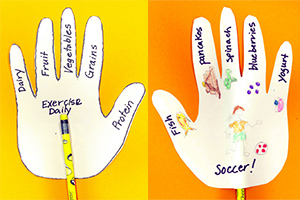 Relevancy and Engagement
dc.agclassroom.org
Relevancy and Engagement
dc.agclassroom.org
Give Me Five!
Grade Level
Purpose
Students examine the five food groups and what state-grown foods fit into each group by making a local connection to good nutrition and a healthy lifestyle. Grades 3-5
Estimated Time
Materials Needed
- Give Me Five! Hand Template, one for each student
- Agricultural Commodities List
- Popsicle sticks
- Scissors
- Glue or Masking Tape
- Crayons and Markers
Vocabulary
commodity: a primary agricultural product that can be bought and sold
Background Agricultural Connections
The five dietary food groups are the building blocks for a healthy diet. Recommendations are set forth by the United States Department of Agriculture (USDA). Food group guidelines were first introduced in 1916. As our knowledge about healthy diets has increased, dietary recommendations, including caloric intake and essential nutrients, have evolved as well.
The 5 dietary food groups include: fruits, vegetables, grains, protein foods, and dairy.
Engage
- Begin by asking students if they have heard of food groups and if so, to raise their hand and share what they know.
- Project the Food Group Puzzle on the board and complete it as a class. Alternatively, you can print the puzzle for smaller groups of students to complete.
- As the students help you complete the puzzle, review the concepts taught. (There are 5 food groups, where each food is produced, common foods in each food group, and nutrients received.)
Explore and Explain
- Explain that food groups are collections of foods with similar nutritional benefits. Nutrition guidelines recommend daily servings from each group for a healthy diet.
- Ask students to name any food groups they know. List answers on the board. Fill in any of the five groups that are not mentioned.
- When all five groups are on the board, review them and discuss how each makes our bodies healthy.
- Ask students to name foods they like to eat in each group. Record answers on the board. In the end, there should be a list of the five food groups and foods in each group.
- Go over the Agricultural Commodities List and star or circle with a bright color all the foods grown in your state (or region).
- Tell students that farmers and ranchers in our state grow thousands of different types of crops and many of them are food we eat. If there are additional commodities grown or raised in your area add them to the list, or list them on the chalkboard.
- Tell students that each day they should eat from the five food groups for a healthy diet – fruits, vegetables, grains, protein and dairy. Have them hold up one hand and list the five groups, one for each finger. After they list off the five groups, have them turn to a partner and give each other a high five. To help them remember the five food groups, students will be making a Give Me Five! hand.
- Each student will need to have a paper hand, a popsicle stick (pencils work too), tape and crayons or markers.
- On one side of the hand, students write the name of a food group on each finger. In the center of the palm they write “Exercise Daily.” (see example below).
- On the other side of the hand students should write/draw a state-grown food for each food group in the corresponding finger area (Ex: fruits/picture of blueberries).
- Have them write/draw their favorite exercise in the palm area. (See example below).
- Students cut out the hand then tape on a popsicle stick at the wrist area.
- When they are done, as a group repeat the five food groups.
- Have students take turns sharing their favorite local foods with the class.

Elaborate
-
Read the book, To Market, To Market, by Nikki McClure. This beautiful story follows a mother and son to the farmer’s market. As they check off items on their shopping list, the reader learns how each particular food was grown or produced, from its earliest stages to how it ended up at the market.
-
Play the My American Farm interactive game Finders Keepers.
-
Read Issue 2 of Ag Today titled Food, Keeping us Fueled for an Active Lifestyle. This reader can be accessed digitally. Learn about the healthy and tasty food that farmers grow to help humans maintain a healthy diet. Follow the process from farm to plate and learn about serving sizes, food safety, and USDA's MyPlate.
Evaluate
After conducting these activities, review the following key concepts:
- The greatest health benefits are received when all five dietary guidelines are followed.
- A balanced diet includes all five food groups.
- Exercise is also important to good health.
- Some foods are produced locally. Other foods are produced in more ideal climates and shipped to local grocery stores.
Recommended Companion Resources
- A Seedy Fruit Challenge
- Ag Today
- AgBadging Field Guide
- Agricultural Stats and Facts
- An Orange in January
- Eat & Move O-Matic App
- Endless Options
- Food Group Puzzle
- Good Enough to Eat: A Kid's Guide to Food and Nutrition
- Mapping Meals Activity
- My American Farm
- MyPlate Activity Poster
- Nutrition Posters
- Plants Feed Me
- Portion Size Comparison
- The Fruits We Eat
- The Healthy Hop 'n Shop
- The Scrambled States of America
- To Market, To Market
- What is a Fruit? What is a Vegetable? Bulletin Boards